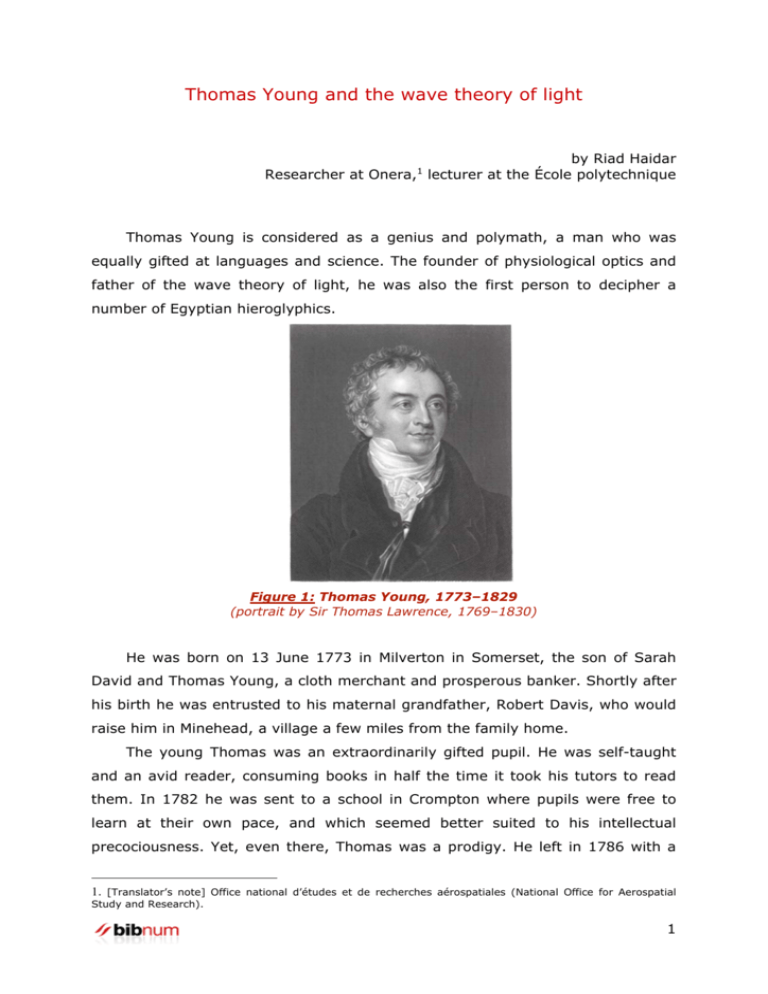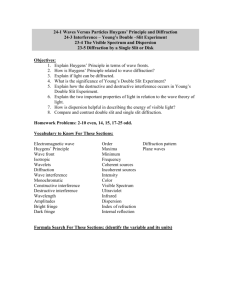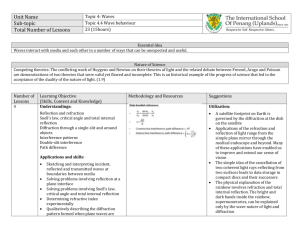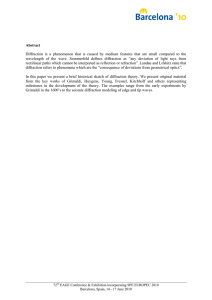Thomas Young and the wave theory of light
advertisement

Thomas Young and the wave theory of light by Riad Haidar Researcher at Onera,1 lecturer at the École polytechnique Thomas Young is considered as a genius and polymath, a man who was equally gifted at languages and science. The founder of physiological optics and father of the wave theory of light, he was also the first person to decipher a number of Egyptian hieroglyphics. Figure 1: Thomas Young, 1773–1829 (portrait by Sir Thomas Lawrence, 1769–1830) He was born on 13 June 1773 in Milverton in Somerset, the son of Sarah David and Thomas Young, a cloth merchant and prosperous banker. Shortly after his birth he was entrusted to his maternal grandfather, Robert Davis, who would raise him in Minehead, a village a few miles from the family home. The young Thomas was an extraordinarily gifted pupil. He was self-taught and an avid reader, consuming books in half the time it took his tutors to read them. In 1782 he was sent to a school in Crompton where pupils were free to learn at their own pace, and which seemed better suited to his intellectual precociousness. Yet, even there, Thomas was a prodigy. He left in 1786 with a 1. [Translator’s note] Office national d’études et de recherches aérospatiales (National Office for Aerospatial Study and Research). 1 solid grounding in Newtonian physics and in optics. He spoke more than twelve European, Oriental, extinct and modern languages. MEDICAL SCHOOL In 1792 he moved to London to study medicine at the Hunterian School, and was accepted as an intern at the Saint Barthelemy Hospital. It was there, while dissecting an ox’s eye, that he discovered the accommodation mechanism, which he attributed to a variation in the curvature of the crystalline lens. He presented his theory in Observations on Vision, which he submitted to the Royal Society of London on 30 May 1793. He was not yet 20 years old. Young spent 1794 at the University of Edinburgh, and then travelled to Germany. He obtained a doctorate in physics at the University of Göttingen on 30 April 1796. He then visited different areas of Germany, including Jena and Berlin, before returning to England in February 1797. In the same year he inherited a house in London from his great-uncle, the doctor Richard Brocklesby, and an annuity large enough to ensure his financial independence. Thomas then enrolled at Emmanuel College, Cambridge, for he needed a British degree to join the Royal College of Physicians and practise as a doctor. He did not, however, attend classes, judging that he already knew enough of the subject. Instead, spurred on by the reading matter of his youth and his discussions on the Continent, he plunged himself into the study of physics and mathematics. He quickly acquired a reputation as both a brilliant mind and rather unsociable character, who was more interested in a difficult calculation or an ingenious instrument than in college life. On graduating in 1799, he moved to London. Yet, despite his talent and dedication, Doctor Young met with little success. He lacked the well-rounded demeanour, tact and bedside manner that patients desire. But by practising medicine and examining the functioning of the eye and the ear, he widened the scope of his reflections, and made the connection between sound and light. FIRST SCIENTIFIC PUBLICATIONS Though Young published his first works early on, he did so anonymously so as to protect his credibility as a doctor, which at the time was incompatible with the dubious reputation of scientists. He submitted a series of papers to the Royal Society of London: Sound and Light in January 1800, On the Mechanism of the 2 Eye in November, and On the Theory of Light and Colours in 1801. The advances were gigantesque: Young offered the first analysis of astigmatism and laid the foundations for our understanding trichromatic colour vision, a study that would be later taken up and developed by Hermann von Helmholtz (1821–1894), and confirmed experimentally in 1956 by Gunnar Svaetichin. 2 But this is only a cursory reading. For the winds of revolution blown by Young would also lead elsewhere, to deeper and more fundamental notions. @@@@@@@ Let’s first consider the background context. Since ancient times, light and vision have essentially remained a mystery. The question of how the eye perceives images had tormented the most prodigious minds, including Pythagoras, Euclid, Epicurus and Aristotle... For centuries the debate had been dominated by two opposing schools of thought, until the publication of Kitab fi’l Manazir by the Persian scholar Ibn al-Haytham, who, in 1020, demonstrated that sight is due to objects emitting rays of light towards the eye. Figure 2: (left) Figure from the Book of Optics by Ibn al-Haytham, known as Alhazen in Latin (Bassorah, c. 965–Cairo, 1039). He wrote his Book of Optics from 1015 to 1021. A Latin translation (Opticae thesaurus) was produced by F. Risner in 1572 (available online via the University of Strasbourg’s digital library – SICD); (right) A figure from a work by Al-Farisi (1267–1320), which describes the anatomy of the eye using Ibn al-Haytham’s research. 2. G.Svaetichin, “Spectral response curves from single cones”, Actaphysiol. Scand. 39, Suppl. 134, 17–46. 3 In his Astronomia pars Optica, published in 1604, Johannes Kepler methodically demonstrated the role of these rays, which he assumed to be exterior to and independent of the eye, in forming images on the retina. At the end of the 17th century, the nature of these light rays (corpuscles or waves?) remained unexplained – as did several other optical phenomena: reflection, refraction, the dispersion of light by a prism, and diffraction. In 1678 Christiaan Huygens (1629–1695) put forward his wave theory of light, which proved particularly useful in discovering the Snell-Descartes law (reflection and refraction). It also provided an embryonic explanation of the phenomenon of diffraction. Formalistically speaking, however, the theory was too inadequately developed to be convincing, and Huygens was unable to produce formal results. Figure 3: Wavelet decomposition by Christian Huygens, in Treatise on Light, published in 1690. After Huygens came Isaac Newton (1643–1727), whose conceptual brilliance and experimental cogency would make his theories of physics authoritative in England and throughout Europe. Like Huygens, he was initially drawn to the wave theory of light, but, like his predecessor, was unable to formulate this theory in a satisfactory manner. The main difficulty he faced was the lack of a suitable mathematical method. In 1704, after years of painstaking work, he settled the question in his imposing Opticks. One or two details notwithstanding, his demonstration is masterful: the corpuscular theory of light elucidated practically all hitherto unexplained optical phenomena. The “theory of fits”3 that Newton developed to model the phenomenon of interferences is, 3. Newton believed that a corpuscle of light, during a trajectory, periodically possessed “fits” of easy transmission and easy reflection, thereby explaining interference fringes, which are alternately dark and light. 4 admittedly, a little overly complex. In addition, he struggled to theorise diffraction. But it would have to do: everyone – or almost everyone – now accepted that light was made up of corpuscles. Problem solved, then. At least until a century had elapsed, Newton’s influence had faded – at least a little – and a mildly wide-eyed scientist dared question his theory. WAVE THEORY OF LIGHT In his paper Sound and Light, presented to the Royal Society on 16 January 1800, Thomas Young pointed out the shortcomings of the Newtonian system, some of which had already been remarked by other scientists on the Continent, such as Leonhard Euler (1707–1783). These “details” did more than sow doubt; for Young, they called the entire corpuscular theory into question. This would lead him to the necessity of a wave theory of light, which travelled through vibrations in the ether, and to the association of colours with the frequency of these vibrations. Two years later, he made the same point more emphatically still: his lecture On the theory of light and colours, delivered on 12 November 1801, was presented as a point-by-point confrontation of his and Newton’s views on a number of concepts. He forcefully reaffirmed his conviction that a wave theory was correct and satisfactory. Proposition VIII, with its interference principle, is undoubtedly the defining moment of the demonstration (p. 34 of the BibNum text): It was a principle that he had already applied to harmonics in Sound and Light, and which he explained as follows: if two undulations of the same frequency coincide exactly, the resulting motion is the most intense; if they differ by half an undulation, the resulting motion is the weakest, if not non-existent. Young’s presentation is complex (he would later simplify it), but it was the first time in history that a theorem had unveiled the workings of diffraction and interferences. 5 He immediately used Proposition VIII to explain a number of phenomena, such as Newton’s coloured rings (the iridescence of thin sheets in layers of equal thickness). Figure 4: The iridescence of light through a thin sheet (Newton’s experiment). Newton gave his name to this phenomenon, which was first discovered by R. Hooke: convex lens L placed on plane sheet P creates air layers of varying thicknesses. Under white light this system produces coloured rings (seen in A), which Newton explains rather laboriously using the theory of “fits” (cf. footnote 3 above). (Image S. Boudreux, website “La Physique au temps de Sigaud de Lafond”); Figure 5, below: diagram of “iridescent rings”, extract of Isaac Newton’s Opticks (Book II, Part I, Plate I, 1704 edition). The argument is surprisingly convincing. He would further refine it in a lecture delivered on 1 July 1802, An account of some cases of the production of colours, not hitherto described, and deduced a general law which states that: Wherever two portions of the same light arrive at the eye by different routes, either exactly of very nearly in the same direction, the light becomes most intense when the difference of the routes is any multiple of a certain length, and least intense in the intermediate state of the interfering portions; and this length is different for light of different colours. 6 This is simple, clearly articulated, and complete. It also introduces the notion of wavelength. And yet, Young aroused only lukewarm interest. Aside from the fact that he presented himself as the equal of the magisterial Newton, this was probably because his approach and conclusions remained qualitative: Young did not support them with any mathematical demonstration or concrete formalism. The definition of a scientific theory by Young In the first paragraph of the BibNum text, Young pens what can be considered the authoritative definition of a theory of physics: Despite this introductory statement of principle, Young was aware of the weakness of his approach, which he decided to consolidate with experimental demonstrations. This is the subject of his famous paper Experiments and Calculations relative to Physical Optics, which he presented to the Royal Society on 24 November 1803 and in which he suggests the term interferences to designate the interaction between light waves – a term that would later be used by Arago in France in relation to the work of Fresnel. It is also in this paper that Young describes the double-slit experiment that is named after him. He shows that in order to observe interference fringes, it is necessary to interfere two waves derived from the same source; the fringes disappear if either one of the waves is concealed. 7 Figure 6: “Young’s double-slit experiment”. The wave originating from the source above, not shown in the figure (Wikipedia image, Tatoute), arrives at the double slit and produces an interference figure, the light intensity of which is shown below (Wikipedia image, Jordgette). @@@@@@@ Having laid down this concept, Young deduced a diffraction mechanism using the surface of a screen. This point deserves attention, because it symbolises the transition from Young to Fresnel. Young’s approach: from the interference principle to the diffraction mechanism While Young is most well-known for his double-slit light interference experiment (known as “Young’s double-slits”), his main legacy was devising an effective model for diffraction based on interferences. The crux of his method is as follows: 1- He takes the wave hypothesis as a starting point, justifying and validating it using simple examples. Thus, in his Proposition III (and Figure 1 in the BibNum text), he describes a slit-based transmission method, which, he argues, is compatible with the wave theory. According to Young, the light that can be observed in the dark zone is generated, in “weak portions of diverging undulations”, by the edges of the aperture. 8 Figure 7: Above, an extract of Figure 1 from Young’s illustrative plates. Part of the transmitted light, originating from temporary source A (not shown in the extract), spreads out in direct vision in the ABC triangle through the aperture. The other part, visible in the dark zone (i.e. outside the ABC triangle) is produced by the surface of the screen. Below, an illustration of slit diffraction (Wikipedia image, Jordegette). 2- He then develops the principle of interferences (Proposition VIII of the BibNum text, cf. above). 3- He adduces a diffraction mechanism based on interferences. Fresnel would extend this mechanism by combining it with Huygens’s wavelet decomposition. FROM YOUNG TO FRESNEL: A NECESSARY IMPROVEMENT Let’s now consider screen diffraction. According to Young, this results from the interference of two waves: one in direct vision and existing in the light zone, the other diffracted and produced by the geometric discontinuities of the screen surface (in A Course of Lectures on Natural Philosophy and the Mechanical Arts, published in 1807). In 1815 Augustin Fresnel (1788–1827), working independently on these questions on the other side of the Channel, devised an initial approach that was very similar to Young’s. But he quickly perceived the limitations of this model, which in particular forecast a difference depending on whether the surface was rounded or rough. His experiments were formal: surface effects do not govern diffraction. Perhaps the aperture itself was the cause…? 9 Adapting the concept of wavelets, introduced by Huygens a century earlier, Fresnel considered the aperture in the screen as being made of a large number of elementary sources, to each of which he attributed a phase. Unlike his predecessors, Fresnel supported his intuition with powerful mathematical formalism. It was a painstaking process, which would take him four years. Ultimately, however, the experiments and calculations corresponded admirably, thereby confirming the accuracy of the mechanism, which quickly became known as the Huygens-Fresnel principle.4 In a letter sent to the young Frenchman dated 16 October 1819, Thomas Young yielded and recognised the conceptual superiority of Fresnel’s model. Nevertheless, his own contribution remained undeniably pertinent, and his legacy, that of laying the foundations of a theory that would revolutionise our conception of light. A UNIVERSAL MIND But let’s return to Young, whose portrait requires its finishing touches. In 1801 the fledgling Royal Institution of Great Britain asked him to teach natural philosophy. Young accepted, and wrote fifty or so classes, which he gave from January 1802 onwards. The curriculum was varied (mechanics, hydrodynamics, general physics, mathematics), very ambitious, and reflected his scientific eclecticism. Young opted for a lecture style, deliberately addressing an informed audience rather than an assembly of students. This meant that his classes failed to convince. He abandoned them in 1803, but in 1807 published the voluminous Course of Lectures on Natural Philosophy and the Mechanical Arts, in which he compiled his lecture notes. In this work, a testament to his formidable creativity, Young introduced the module which bears his name and describes the elastic deformation of a material in relation to the force applied. His taste and talent for languages, developed at a very early age, drove Young to study ancient Egyptian texts. The story began in June 1814, when a friend brought him a papyrus written in demotic. Young was quickly hooked and set his mind to the Rosetta Stone – bearing a text repeated in Greek, demotic and hieroglyphics – and which has been exhibited at the British Museum since 1802. Guided by his mathematical intuition and method, he suggested an astute 4 See the BibNum analysis text by J.-L. Basdevant on Fresnel’s Premier mémoire sur la diffraction de la lumière (1815). 10 conjectural translation, which allowed him to transcribe some 220 cartouches – a number of which would be confirmed by Champollion’s (1790–1832) complete deciphering in 1822. In 1827 Thomas Young was elected foreign associate of the Academy of Sciences at the Institute of France. This was a rare honour, and one of the few he would receive in his lifetime. His health deteriorated dramatically in 1828 during a voyage to Geneva. He was beset by respiratory difficulties in February 1829, and died the same year, on 10 May, in London. (January 2011) (Translated in English by Helen Tomlinson, published September 2014) The author wishes to thank Alexandre Moatti for carefully rereading and adding illustrations to this manuscript. 11






